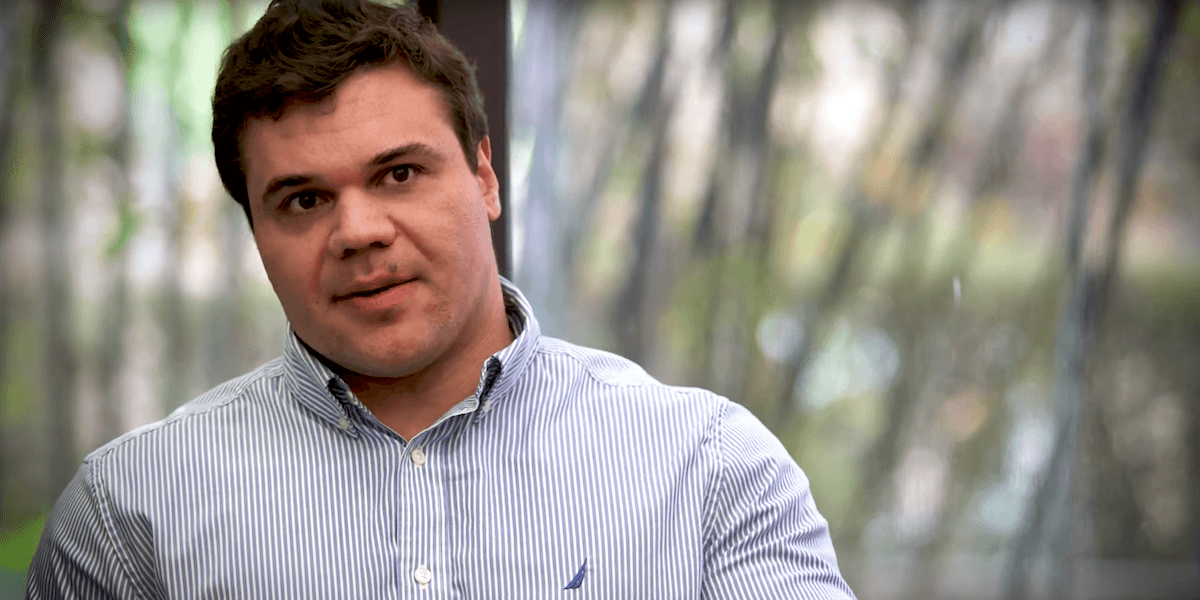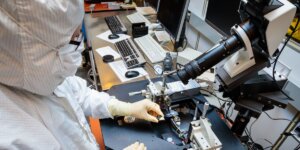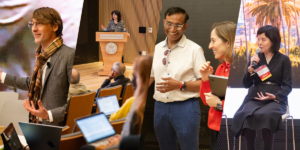
Constantine Sideris, assistant professor of electrical engineering at USC, was recently honored with the prestigious award from the Air Force. Image Credit: Dennis Lee
Constantine Sideris, an assistant professor of electrical and computer engineering at the USC Viterbi School of Engineering, is one of only 40 researchers across the country selected this year to receive a prestigious three-year, $450,000 grant from the Air Force Office of Scientific Research’s Young Investigator Program.
The program allows early-career scientists who received a Ph.D. in the last seven years to jumpstart career-defining research projects.
Sideris and his team, the ACME laboratory: http://sites.usc.edu/acmelab, will use the nearly half-million-dollar grant to work on improving the design of photonic integrated circuits. Unlike traditional integrated circuits, photonic integrated circuits (PICs) work by manipulating light instead of electricity. The project aims to streamline the modeling and design process behind photonic circuitry to make it easier for engineers to build and improve light-powered circuits, paving the way for many exciting upcoming technologies such as optical computing.
In the U.S., Verizon’s Fios service is built on an infrastructure of fiber-optic cables that use light to send data such as images, documents, and emails over the internet. This is an example of photonic circuitry at work, where it’s been shown to work faster, literally at the speed of light, and reach longer distances than traditional wireless broadband.
Today, photonic integrated circuits are primarily used in communication technologies with nascent applications, including automatic LIDAR for self-driving cars, biosensors, and optical computers. However, PICs remain very challenging to model and design because traditional lumped circuit model approximations cannot be used, instead requiring a full solution of Maxwell’s equations for every design. Sideris believes that using computer algorithms to automate the design of photonic circuits is essential for realizing larger and more complicated photonic systems as the technology matures
“The problem I’m interested in tackling is coming up with techniques, or algorithms, to automate the design of devices that an engineer would normally have to design manually, only requiring desired behavior of the device to be specified as human input.” he said.
But approaching this problem is not easy. “We need to be able to simulate these devices accurately first in order to design them, and simulating photonic circuits is extremely challenging.”
Currently, engineers design many of the underlying components of these light-powered microchips via a painstaking manual iterative process with slow commercial simulators on a trial and error basis, which can be costly and time-consuming. Instead, Sideris seeks to design algorithms that make the computer responsible for designing the device structure, only requiring the engineer to specify their desired performance specifications and fabrication constraints, thereby allowing humans to focus on the higher level aspects of the whole system.
Teaching a computer how to design photonic circuits, he said, “not only would save designers time, but opens opportunity for designing new devices with nonintuitive structures that humans would likely never come up with on their own.”
This would potentially eventually allow engineers to design photonic microchips by specifying desired behavior at a high level and letting the computer design the actual hardware to be fabricated, similar to how digital microcomputers are designed today. If successful, the project, “could completely change the paradigm of engineering electromagnetic devices,” Sideris said.
Sideris received his bachelor’s, master’s, and Ph.D. degrees in Electrical Engineering from the California Institute of Technology. He also spent time as a visiting scholar at the University of California, Berkeley’s Wireless Research Center (BWRC), where he worked on designing plastic waveguide-based interconnects — made of high density polyethylene, the same material as milk cartons — as a cost-effective and energy-efficient way of transmitting data across microchips.
Microchips are a tiny piece of technology that have majorly transformed the world of electronics, from mobile phones to digital thermostats. However, many of these technological improvements have only employed electronic circuits. He aims to change that.
As an academic researcher, Sideris values collaboration with other engineers – something that is easy to come by at USC Viterbi.
“USC has a wealth of top-level researchers,” he said. “I love how many different researchers there are in different areas all working at the cutting edge of their field.”
Sideris joined USC Viterbi’s Ming Hsieh Department of Electrical and Computer Engineering in August 2018. On the tenure track, he alternates between teaching linear circuits for undergraduates and computational electromagnetics for graduate students. He designed the course, titled “Build Your Own Simulator,” as a way to teach emerging engineers how to design their own code that can simulate the design of electromagnetic devices.
Published on January 30th, 2020
Last updated on May 16th, 2024












